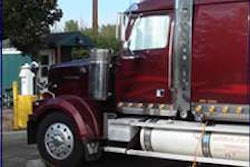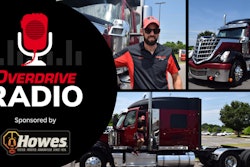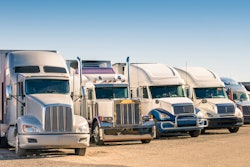New engine technology promises not only improved engine efficiency, but also the ability to spec your drivetrain to further enhance fuel economy.
Exhaust gas recirculation creates higher exhaust backpressure and slower combustion in the cylinders, which reduces fuel economy. How can the situation be remedied?
One answer is proving to be selective catalytic reduction. SCR technology in 2010-2011 engines has a beneficial side effect: It allows engineers to reduce EGR levels by retuning engine parameters. This yields an often-overlooked side benefit – an enhanced ability to produce power and torque. By smartly spec’ing your transmission and drive axles to give a lower cruise rpm, you can take advantage of engines that pull better, and can increase fuel economy even beyond the gains produced by the retuning.
Don’t underestimate the value of low rpm cruising. The most efficient diesels are the slow-turning, ocean-going ship engines. Some turn at only a tenth of the rpm of a modern truck diesel.
“We’re selling torque, not horsepower,” says Ed Saxman, product marketing manager for Volvo. He points to Volvo’s 13-liter engine, which produces 500 hp and 1,750 lb.-ft. of torque, as an example.
For Detroit Diesel’s DD15, “The torque lasts down to 1,000 rpm,” says Chuck Blake, Detroit Diesel’s senior technical sales support manager. The company’s amplified common rail system produces maximum injection pressure at these lower rpms, which smoothes out low rpm combustion and enhances torque. In addition, the camshaft no longer has the job of operating unit injectors, and is driven by the rear end of the crankshaft where the flywheel is. These changes mean much less vibration produced by the engine’s mechanical parts. As a result, “It won’t miss a beat at that rpm,” Blake says.

Manufacturers are pegging their engine sweet spots in a tight range. Saxman says Volvo’s is 1,375 rpm. Mack’s Dave McKenna, Mack powertrain products marketing manager, says 1,350-1,450 is satisfactory, but for best fuel economy he recommends 1,300-1,350.
Cummins’ Zack Ellison, manager of customer technical support, says for the 15-liter ISX, 1,350-1,360 is recommended for most fleet specs, while up to 1,400 is considered satisfactory for higher-powered versions, depending upon desired performance. Cummins’ online Power Spec tool pegs the ideal cruise rpm at 1,380 for an on-highway truck with a 500-hp engine hauling less than 80,000 pounds at 65 mph. Cummins’ higher-powered ISXs have their torque peak at 1,200 rpms, while the standard fleet engine peaks at 1,100.
Blake says the DD15 should be geared at between 1,350 and 1,450 rpm at cruise, and at the high end of the range when climbing hills.
“Torque is important,” says Steve Slesinski, director of global product planning for Dana Holding Co. “Three or four years ago, it was very different from today. We’re seeing a trend downward in rear axle ratios from 3.70:1 and 3.55:1 axles down to 3.42:1 and 3.36:1. The industry will continue to migrate to low rpm and faster axles as drivetrains improve.”
Slesinski says you should gear for your average cruise speed, not for an occasional condition. He says you’d normally spec’ a 3.55:1 axle with a 0.73:1 overdrive ratio for 65 mph, but could go as low as 3.25:1 for a 75-mph cruise.
“Cruise rpm will continue to drop,” says Shane Groner, Eaton North America product planning manager. Typically it will go “from 1,400 down toward 1,300 rpm, with torque on the average engine holding at well below 1,200 or even 1,100 rpm.”
He says Eaton has tested drivetrains, even those running direct-drive axles, which can carry much more torque, at cruise rpms as low as 1,100.
Transmission options
Additional steps can be taken to increase fuel savings. One is to spec a 13-speed or 18-speed transmission instead of a 10-speed.
Eaton’s Shane Groner says a 13- or 18-speed can “keep the rpm right where it’s supposed to be.” These transmissions have a 17 percent gear step instead of the 34 percent step of a typical 10 speed. Availability of multi-torque models that give the driver extra zoom only in the top gear and one split down enhance the potential of the devices.
Detroit Diesel’s Chuck Blake notes the challenge is keeping the operator from using the split to downshift early and use more engine rpm than necessary. But when you’re on a steep enough grade to carry you too far below peak torque and you need to shift, “instead of shifting down a whole gear, you can split down and get half a gear,” he says.
Groner says these transmissions have a higher resale value. Eaton has a web-based training video that shows how to effectively use multi-speed gearboxes to enhance rather than diminish fuel economy. (Search “Super 18” on roadranger.com for the links to the main product page and the video). Mack’s Dave McKenna says if your cruise speeds vary widely, a 13- or 18-speed transmission could be ideal. Both Mack’s m-Drive and Volvo’s i-Shift automated transmissions have 12 speeds. This reduces the typical 37 percent drop in rpm after an upshift, which occurs with a 10-speed, to a mere 28 percent, notes Volvo’s Ed Saxman.
“This gives the computer great flexibility in skip shifting, in effect allowing it to bite off a step and a half of what you’d get shifting one gear in a 10-speed,” he says. Such shifting keeps rpm low, yet by reducing the number of times the turbo needs to spin up, speeds acceleration.
McKenna says the 12-speed m-Drive will downshift under cruise conditions at around 1,280 rpm and hold an rpm at around 1,325.
Direct drive transmissions save fuel because the power goes directly through the gearbox without passing through any gear meshes, which reduces friction. The gearing also turns more slowly, which reduces churning of the oil, a source of energy loss. Blake says, “Direct drive gives you a 2 percent to 3 percent increase, or 0.1 mpg, partly because you’re in top gear (direct) over 80 percent of the time.”
The manufacturers’ reps say you need to pick a transmission like an FR series Fuller, rather than the more standard RT, for direct drive, with a more powerful reverse gear, so you can still crawl backwards with the clutch engaged.
Dana’s Steve Slesinski says, “Overdrive transmissions are still the most popular, but some are using direct drive to save fuel.” A typical axle ratio for a direct drive setup would be 2.64:1, he says. Because overdrive ratios substitute driveshaft rpm for torque, you’ll need a higher-torque driveshaft for use with direct drive. “We design the axles to handle the extra torque,” he notes.
Slesinski suggests choosing a 6×2 arrangement where you get the same suspension and tandem axles, but only the forward axle drives. You’ll get an additional 2 percent to 3 percent fuel improvement because of reduced friction, he says.
Meritor also offers 6×2 setups, says Charlie Allen, global service director. He says a special suspension design allows the operator to lift the rear tandem and place all the weight on the forward drive axle while driving on slippery roads.
Blake says another fuel-saving feature is that Detroit Diesel engines can wait till the coolant reaches 225 degrees F. to turn on the fan because of the reduced heat loads of SCR engines, thus significantly reducing fan on time, a big source of fuel consumption.
The value of multi-torque
Torque enhancement doesn’t stop with the higher ratings and the more potent torque curves of today’s engines. Every manufacturer offers a multi-torque system that cranks up torque beyond its base level under certain conditions. These serve the same purpose as recommending a torque curve with torque that rises a lot as rpm falls — an incentive to keep an operator from downshifting too early.
Such arrangements are ideal for company drivers who may not drive with the same attention to fuel economy as an owner-operator. Multi-torque is also a practical way to increase performance while retaining fuel economy.
The systems normally confine an ECM-controlled torque boost of 100-200 lb.-ft. to certain operating conditions, such as being in the top two gears. They provide maximum cruise performance at minimum cost because the torque to which driveshafts and axle parts are subjected increases by the ratio in the transmission. For the top two gears, the torque increase is only a fraction of what it would be down in the lowest gears.
Eaton’s Shane Groner says the company designs a number of its transmissions for multi-torque applications, including 13- and 18-speed models. Driveshafts and axles are relatively insensitive to the torque increase, but the input side of the transmission needs to be designed for the extra twisting force. The added torque shows up in the top two gears with a 10-speed and in the top two gear splits, both of which are used only in the top main gearbox position, in the 13- and 18-speed models.
The other advantage multi-torque provides is a more powerful incentive for the operator to shift properly. An engine with a good torque curve tends not to lose as much speed on hills, thereby encouraging the driver not to downshift. A multi-torque arrangement may actually provide a slight power loss when downshifting, or at least no more than a negligible increase. When the driver realizes this, he just leaves the transmission in the higher gear.
“With multi-torque,” says Volvo’s Ed Saxman, “you can get up to 1,750 lb.-ft. of torque even on a 425 [hp engine]. It will pull with a 475. Heading down toward 1,300 rpm, the torque comes on. It will lug down on a 3 percent grade and suddenly the truck stops slowing down.”
Mack’s Dave McKenna says the company’s Econodyne engines have a special characteristic called EconoBoost. If the driver is climbing a hill at full throttle and keeps the engine below 1,300 rpm for at least four seconds in the top two gears, he gets an extra 200 lb.-ft. of torque. The MaxiCruise engines have extra torque rise in all the gears, but the EconoBoost arrangement means an even stronger incentive not to downshift.
“Our SmartTorque system gives an extra 100-200 lb.-ft. in the top two gears,” Zack Ellison says of Cummins technology. “The benefit is that you don’t need as strong a transmission and other drivetrain parts. You can climb a lot more hills without a downshift. The longer you keep it in top gear, the more efficient the whole system is. The percentage of time spent in top gear indicates what kind of fuel economy you are going to get.”
In Detroit Diesel’s system, says Chuck Blake, several ratings with 1,550 lb.-ft. of torque increase to 1,750 lb. ft. when in the top two gears. “The multi-torque systems protect the driveshafts.”
Navistar’s MaxxForce Big Bore offers higher maximum torque in its multi-torque setup, increasing torque from 1,700 lb. ft. to 1,750, says Tim Shick, director of marketing and field support. Navistar designed this engine with a compacted graphite iron block and cracked-cap connecting rods with its torque peak at 1,000 rpm, thus enhancing its ability to allow the truck to cruise at low rpm.












